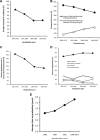Are MD-PhD programs meeting their goals? An analysis of career choices made by graduates of 24 MD-PhD programs
- PMID: 20186033
- PMCID: PMC4441397
- DOI: 10.1097/ACM.0b013e3181d3ca17
Are MD-PhD programs meeting their goals? An analysis of career choices made by graduates of 24 MD-PhD programs
Abstract
Purpose: MD-PhD training programs provide an integrated approach for training physician-scientists. The goal of this study was to characterize the career path taken by MD-PhD program alumni during the past 40 years and identify trends that affect their success.
Method: In 2007-early 2008, 24 programs enrolling 43% of current trainees and representing half of the National Institutes of Health-funded MD-PhD training programs submitted anonymous data on 5,969 current and former trainees.
Results: The average program enrolled 90 trainees, required 8.0 years to complete, and had an attrition rate of 10%. Nearly all (95%) of those who graduated entered residencies. Most (81%) were employed in academia, research institutes, or industry; 16% were in private practice. Of those in academia, 82% were doing research and at least 61% had identifiable research funding. Whereas two-thirds devoted more than 50% effort to research, only 39% devoted more than 75% effort. Many with laboratory-based PhDs reported doing clinical, as well as basic and translational, research. Emerging trends include decreasing numbers of graduates who forego residencies or hold primary appointments in nonclinical departments, increasing time to graduation, and expanding residency choices that include disciplines historically associated with clinical practice rather than research.
Conclusions: Most MD-PhD program graduates follow career paths generally consistent with their training as physician-scientists. However, the range of their professional options is broad. Further thought should be given to designing their training to anticipate their career choices and maximize their likelihood of success as investigators.
Figures



Comment in
-
The urgent need to increase support for the NIH's MD-PhD student fellowships.Acad Med. 2011 Mar;86(3):277; author reply 277-8. doi: 10.1097/ACM.0b013e3182084542. Acad Med. 2011. PMID: 21346431 No abstract available.
References
-
- Ley TJ, Rosenberg LE. The physician–scientist career pipeline in 2005: Build it, and they will come. JAMA. 2005;294:1343–1351. - PubMed
-
- National Institute of General Medical Sciences [November 25, 2009];MSTP study: The careers and professional activities of graduates of the NIGMS Medical Scientist Training Program. Available at: http://publications.nigms.nih.gov/reports/mstpstudy/#10.
-
- Martin JB. Training physician–scientists for the 1990s. Acad Med. 1991;66:123–129. - PubMed
MeSH terms
Grants and funding
LinkOut - more resources
Full Text Sources
Other Literature Sources
Miscellaneous

